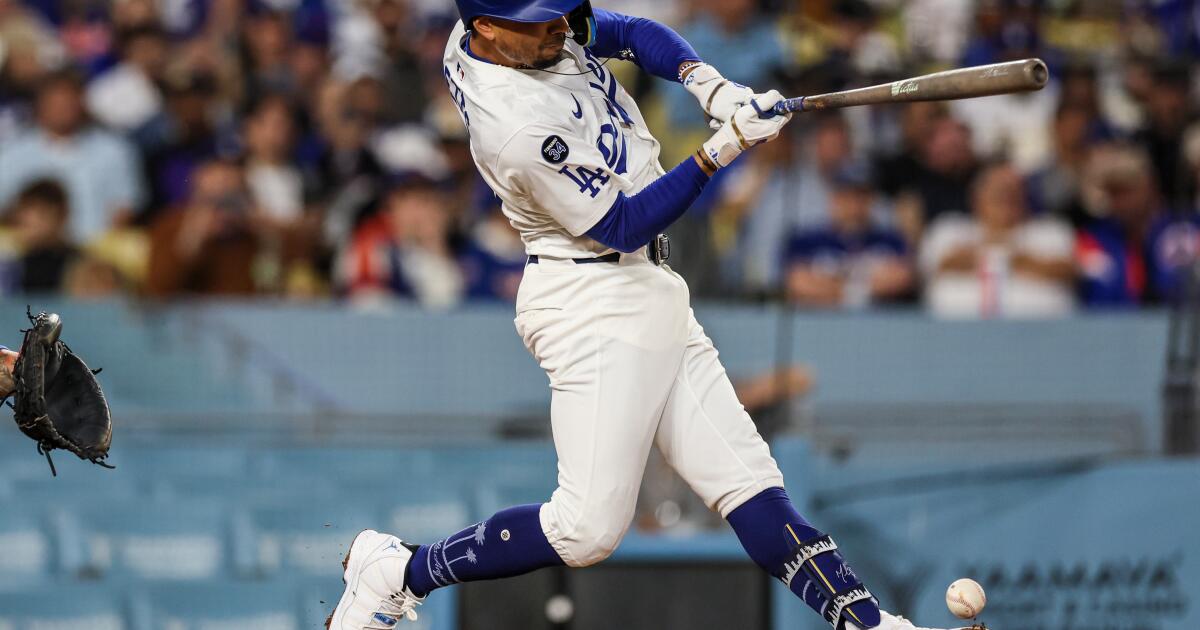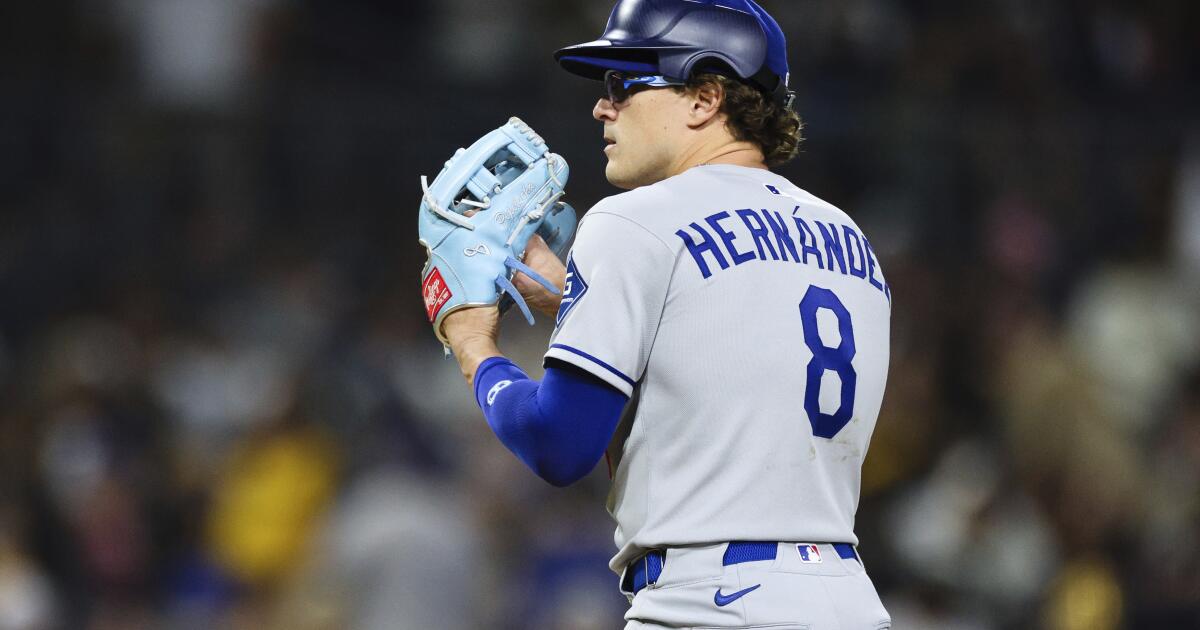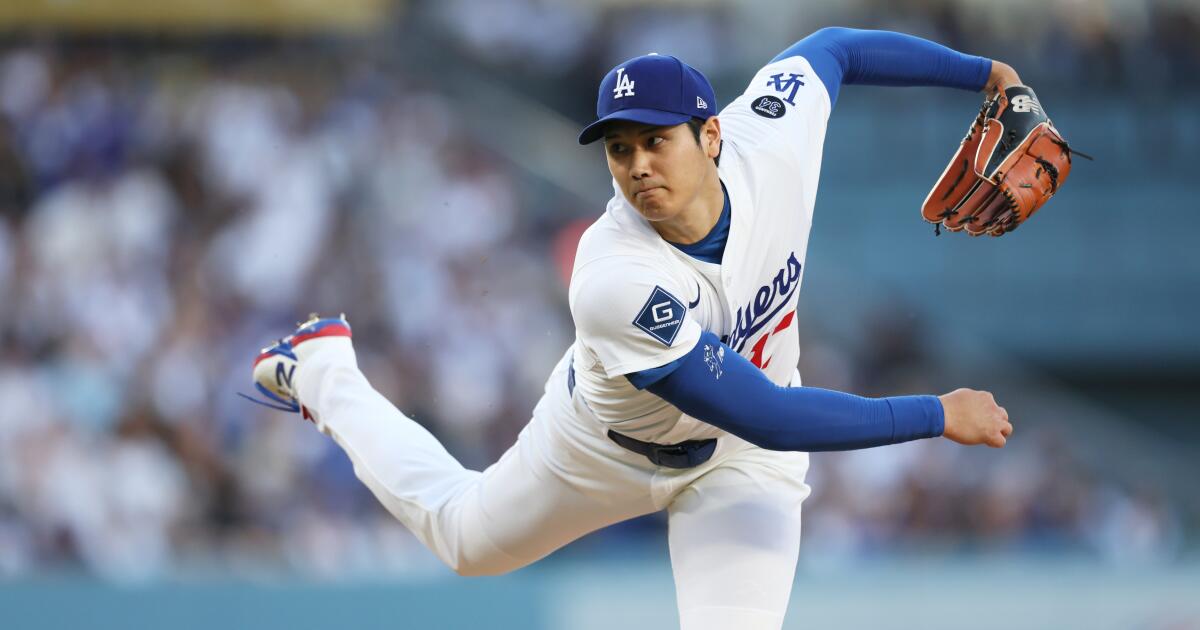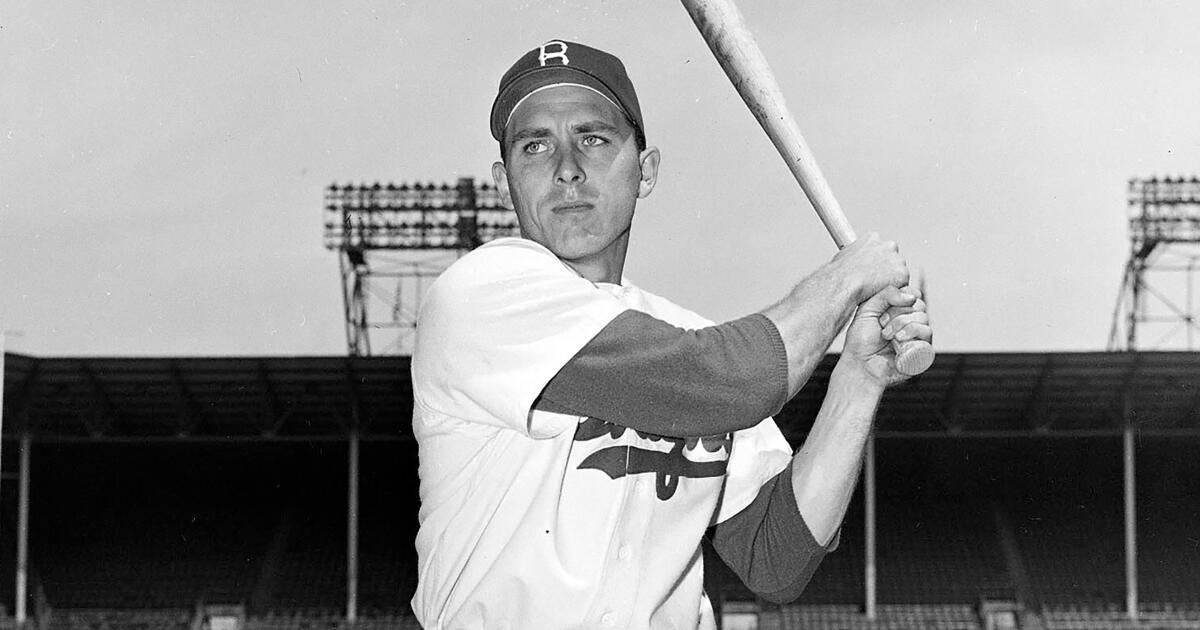Dodgers Dugout: Should the Dodgers be worried about Mookie Betts?
Hi, and welcome to another edition of Dodgers Dugout. My name is Houston Mitchell. It has been so hot the last couple of days, my neighborhood ice cream man has changed the sign on his truck to just say “cream.”
Newsletter
Are you a true-blue fan?
Get our Dodgers Dugout newsletter for insights, news and much more.
You may occasionally receive promotional content from the Los Angeles Times.
Once again, so you don’t get tired of hearing from me, I have reached out to someone else to answer some frequently asked questions. We welcome my Times colleague Jack Harris, who is our main Dodgers reporter.
Q. The most-often asked question I get now is “Why is Michael Conforto playing so much while Hyeseong Kim rides the bench?” So, why?
Harris: A couple of reasons:
1) Kim’s best defensive position, second base, has been blocked lately by Tommy Edman, who hadn’t been able to play the outfield in recent weeks because of his nagging ankle injury. Kim has primarily been in center field as a result, where his fundamentals aren’t nearly as polished.
2) The Dodgers guaranteed Conforto $17 million this offseason, and still have hope he can turn things somewhat around offensively. At least until the deadline, they need to keep giving him opportunities to see whether he can be a contributor, and if not, whether that’s an area they need to target reinforcements.
That said, Edman did return to outfield duties this week. And Dave Roberts has indicated the playing time between Kim and Conforto will start to even out (though both sat plenty this past week because the Dodgers faced several left-handed starters).
My guess is, over the next couple months, Kim will become a more regular member of the starting lineup — assuming he continues to hit. But in the meantime, you’ll still see Conforto (who, in fairness, has shown some signs of life lately) get regular starts as well.
Q. Max Muncy turns his season around, in some part because he started wearing glasses. Last season, it was discovered that Kiké Hernández needed glasses. Why isn’t a comprehensive eye exam part of every spring training?
Harris: As Hernández noted when we wrote about this last year, players typically do get eye exams in spring training. However, in both his and Muncy’s cases, they had very subtle imperfections that weren’t flagged until they visited with an eye specialist.
Muncy himself said his vision is 20/12 (which, presumably, is why his eyesight had never come under question before), but that the astigmatism he learned he had in his right eye left him left eye dominant; not ideal for a left-handed hitter. He insists the glasses are only part of why he’s been better recently, noting a breakthrough with his swing as the bigger difference the past couple months.
Still, Muncy and Hernández are not the first big-leaguers to discover they could benefit from glasses (Hernández said he first heard a similar story from Martín Maldonado). I wouldn’t be surprised if it’s something that gets a closer look — pardon the pun — in the future from teams.
You can read more about Muncy’s turnaround here.
Q. Your best guess on when these pitchers will return: Blake Snell, Tyler Glasnow and Roki Sasaki.
Harris: Glasnow will need at least two more rehab outings. If those go well, that should line him up to return shortly after the All-Star break.
Snell should probably be ready to start facing hitters this upcoming homestand, if not soon after. He’ll probably need a couple of live sessions, then 3-4 minor-league rehab outings. And since those happen one week at a time, I’d say early August is a safe bet.
Sasaki is a much bigger question. He got a shoulder injection earlier this month, and was feeling much better this last week, according to Roberts. But he still hasn’t thrown a bullpen, let alone come close to facing hitters. There’s time for him to come back if he can keep progressing, but it would probably be closer to September at this rate. Tony Gonsolin, who remains shut down from throwing himself, is probably in a similar boat.
Q. It was interesting that after Emmet Sheehan pitched so well in his lone start for the Dodgers (four innings, one run, three hits, six strikeouts) that they would send him down after that. What was the thinking there?
That was a surprise to me. But the way the Dodgers looked at it, Sheehan wasn’t fully built up yet, and they needed someone to pitch Tuesday and Sunday (so on four days’ rest) this past road trip — with the first at hitter-friendly Coors Field, no less.
Thus, the team decided it’d be better to let Sheehan continue stretching out in a more controlled environment in Oklahoma City, and keep Justin Wrobleski on the big-league roster for those two outings.
Sheehan will be eligible to return during next weekend’s Astros series, and Roberts has indicated there will be an opportunity for him to start games once they get there. But for now, Wrobleski has also continued to impress in his extended opportunity.
For perhaps the first time all year, the team might actually soon have some legitimate starting pitching depth (but don’t blame me if I just jinxed it).
Q. Should we be worried about the down season Mookie Betts is having at the plate?
Panicked? No. But somewhat concerned? Probably.
While Betts has always been a relatively streaky hitter, the numbers he is on pace for this year would be career-lows across the board.
Granted, he was affected by his early season stomach virus, and did bat better than .300 over 32 games from late April through the first week of June. But overall, he simply hasn’t generated as much power or hard contact as he usually does (he has only six home runs in his last 73 games), and his already underwhelming bat speed has continued to decline.
I’d still expect him to bounce back, at least to some extent, in the second half. But until he does, the more you have to wonder whether — at age 32 — he is starting to enter a new, less productive, stage of his career offensively.
The other explanation, of course, is that his (ever-impressive) shortstop play is taking some toll on him at the plate. However, he has continually denied that, and noted how last year he was posting MVP numbers while grinding just to learn the position, so I remain dubious of that theory.
Q. In a best-case scenario, how many innings would Shohei Ohtani be able to pitch in a start by the end of the season?
There’s no reason he can’t get stretched out to make full-length starts of 6-7 innings by the end of the season.
The question is whether that will make most sense for the Dodgers down the stretch run of the year.
Ohtani’s bat remains the single most important piece of the team’s chances to repeat as World Series champions. The more he pitches, the more variables that are introduced to his offensive capabilities.
It’s worth remembering, Ohtani turns 31 next week. Even his seemingly superhuman strengths have their limits. And Roberts has alluded to bouts of minor fatigue he has dealt with since beginning to ramp up as a pitcher.
My guess is, if the rotation remains ravaged by injuries and there are pitching holes to plug come October, Ohtani will be treated like more a normal starter.
But, if the Dodgers have three to four other healthy starters they trust by then, it might make more sense to limit his innings — and perhaps use him as a de facto opener in bullpen games instead.
That’s why, for now, the team is in no rush to increase his innings. They’re letting him build a foundation a few innings at a time, and will see how the rest of the staff shapes up before adding even more to his plate.
Q. The Dodgers seem to have had a rain delay everywhere they go this season. What do you do in the press box during a rain delay?
It’s always a good time to get caught up on other stories I’m working on (that’s how I spent most of Sunday’s hourlong delay).
Otherwise, either eat, watch other games around the league, or talk to fellow reporters in the press box.
The best delay was definitely at Coors Field this past week. It was their “hometown hoedown” theme night, so they were doing country music karaoke on the scoreboard. Wisely, Garth Brooks’ “Friends in Low Places” was one of the songs (my personal go-to whenever I stumble into a karaoke bar). There might have been some singing from yours truly in the press box that night.
NL All-Star lineup could be all Dodgers
The two finalists for All-Star starter at each position have been announced, and there’s a Dodger or two at each position, so it’s possible that almost the entire NL starting lineup could be Dodgers.
As the top vote-getter in the NL, Shohei Ohtani is guaranteed to start at DH. The other finalists:
National League finalists
Catcher: Will Smith, Carson Kelly (Cubs)
First base: Freddie Freeman, Pete Alonso (Mets)
Second base: Ketel Marte (Diamondbacks), Tommy Edman
Shortstop: Francisco Lindor (Mets), Mookie Betts
Third base: Manny Machado (Padres), Max Muncy
Outfield: Pete Crow-Armstrong (Cubs), Teoscar Hernández (Dodgers), Ronald Acuña Jr. (Braves), Kyle Tucker (Cubs), Andy Pages (Dodgers), Juan Soto (Mets)
They are listed in the order they finished in the balloting. Voting began Monday at 9 a.m. PDT and concludes Wednesday at 9 a.m. PDT. Voting can be done online at MLB.com/vote. The first round of voting is thrown out, and only votes received from Monday-Wednesday will count.
Steve Henson has a closer look at this here.
Austin Barnes update
Former Dodger Austin Barnes, released by the team earlier this season, has signed a minor-league deal with the San Francisco Giants.
Barnes has been assigned to the Giants’ Arizona Complex League team, probably to work himself back into playing shape before heading to triple A or the Giants. If he makes the Giants, they will owe him the prorated portion of the MLB minimum salary of $760,000, and the Dodgers will owe the remainder of the $3.5 million Barnes was due for the 2025 season.
The Giants’ president of baseball operations is Buster Posey, who was the longtime catcher for the team and the backstop for three World Series title teams. Their starting catcher, Patrick Bailey, has struggled mightily this season. The Giants have a mix of veterans and youngsters in the starting rotation, and a guy such as Barnes could prove beneficial for all of them, as he was always considered almost an extra coach for the Dodgers. Or, he could play poorly in Arizona and they never bring him up. Either way, it won’t cost them much.
Catching up with Walker Buehler
Colleague Bill Shaikin caught up with former Dodger Walker Buehler when the Boston Red Sox were in town to face the Angels recently. Buehler has struggled mightily with the Red Sox this season. He is currently 5-6 with a 6.45 ERA.
Among Buehler’s quotes:
“Somehow, this year, I’ve managed to do all the negative things you can. I’ll keep working. It’s just tough to let down our team….”
“I think, in all honesty, it’s a lot easier to stay good than to get good. The guys on the other side of the field from me drive nice cars, get paid a lot of money to be really good at what they do. Outside of a couple swings [during the Angels game], I think largely I beat myself, which is just not something that you can do here.
“I think it’s in there. I think my arm still moves good. I think I can still make the ball move. I think I can still pitch in the major leagues.
“At some point, the belief, it gets hard to keep tricking yourself. At some point, I have got to put some results up there, for myself, but also for this organization.”
One impressive thing about Buehler, is he never hides when he’s doing poorly. He will stand there and answer questions. Hopefully, he rebounds and becomes a productive pitcher again. Though you have to wonder, after seeing him in last year’s World Series, if he would be better off as a high-leverage reliever now.
You can read the whole story here
Scheduling note
With the Fourth of July holiday Friday, the next Dodgers Dugout will be early next week. I hope you all have an enjoyable holiday weekend. When we return, we will resume our “Top 10” at each position series.
These names seem familiar
A look at how some prominent Dodgers from the last few seasons are doing with their new team (through Sunday). Click on the player name to be taken to the Baseball Reference page with all their stats.
Batters
Cody Bellinger, Yankees: .270/.332/.460, 319 plate appearances, 15 doubles, 3 triples, 11 homers, 42 RBIs, 120 OPS+
Michael Busch, Cubs: .273/.363/.512, 292 PA’s, 13 doubles, 3 triples, 14 homers, 49 RBIs, 150 OPS+
Jason Heyward, Padres, .176/.223/.271, 95 PA’s, 2 doubles, 2 homers, 12 RBIs, 37 OPS+, on the IL
Gavin Lux, Reds: .272/.359/.391, 276 PA’s, 15 doubles, 1 triple, 4 homers, 37 RBIs, 103 OPS+
Zach McKinstry, Tigers: .283/.357/.450, 287 PA’s, 11 doubles, 8 triples, 5 homers, 25 RBIs, 128 OPS+
Joc Pederson, Rangers, .131/.269/.238, 146 PA’s, 5 doubles, 1 triple, 2 homers, 6 RBIs, 50 OPS+, on the IL
Keibert Ruiz, Nationals, .248/.279/.321, 258 PA’s, 12 doubles, 2 homers, 24 RBIs, 72 OPS+
Corey Seager, Rangers: .244/.342/.430, 225 PA’s, 6 doubles, 10 homers, 23 RBIs, 123 OPS+
Chris Taylor, Angels: .200/.294/.400, 34 PA’s, 3 doubles, 1 homer, 3 RBIs, 94 OPS+, on the IL (numbers with Angels only)
Justin Turner, Cubs: .210/.293/.267, 123 PA’s, 3 doubles, 1 homer, 12 RBIs, 63 OPS+
Trea Turner, Phillies: .296/.348/.456, 368 PA’s, 17 doubles, 2 triples, 11 homerss, 38 RBIs, 119 OPS+
Miguel Vargas, White Sox: .229/.311/.411, 334 PA’s, 20 doubles, 2 triples, 10 homers, 34 RBIs, 103 OPS+
Alex Verdugo, Braves: .242/.297/.294, 209 PA’s, 10 doubles, 12 RBIs, 67 OPS+
Pitching
Ryan Brasier, Cubs: 0-0. 1.32 ERA, 13.2 IP, 10 hits, 3 walks, 11 K’s, 296 ERA+
Walker Buehler, Red Sox: 5-6, 6.45 ERA, 67 IP, 74 hits, 32 walks, 59 K’s, 65 ERA+
Jack Flaherty, Tigers: 5-9, 4.80 ERA, 84.1 IP, 69 hits, 35 walks, 100 K’s, 82 ERA+
Kenley Jansen, Angels: 1-2, 4.40 ERA, 15 saves, 28.2 IP, 28 hits, 11 walks, 26 K’s, 95 ERA+
Craig Kimbrel, Rangers: 0-0, 0.00 ERA, 1 IP, 1 hit, 1 walk, 1 K, in the minors
Kenta Maeda, Cubs: 0-0, 7.88 ERA, 8 IP, 9 hits, 6 walks, 8 K’s, 52 ERA+, in the minors
Ryan Pepiot, Rays: 5-6, 3.36 ERA, 96.1 IP, 81 hits, 30 walks, 92 K’s, 118 ERA+
Max Scherzer, Blue Jays: 0-0, 5.63 ERA, 8 IP, 9 hits, 3 walks, 5 K’s, 77 ERA+
Ryan Yarbrough, Yankees: 3-1, 3.90 ERA, 55.1 IP, 48 hits, 17 walks, 49 K’s, 105 ERA+, on the IL
Is there a player you’d like to see listed here? Email me at [email protected] and let me know.
Up next
Tuesday: Chicago White Sox (Shane Smith, 3-5, 3.38 ERA) at Dodgers (Yoshinobu Yamamoto, 7-6, 2.61 ERA), 7:10 p.m., Sportsnet LA, AM 570, KTNQ 1020
Wednesday: Chicago White Sox (Sean Burke, 4-7, 4.22 ERA) at Dodgers (*Clayton Kershaw, 4-0, 3.03 ERA), 7:10 p.m., Sportsnet LA, AM 570, KTNQ 1020
Thursday: Chicago White Sox (Aaron Civale, 1-4, 4.74 ERA) at Dodgers (Dustin May, 4-5, 4.68 ERA), 7:10 p.m., Sportsnet LA, AM 570, KTNQ 1020
*-left-handed
In case you missed it
More than the glasses: How a lightbulb moment made Max Muncy a ‘complete hitter’ again
Dodgers pursue record for most MLB All-Star starters as voting resumes for 48 hours
Why Mookie Betts and Freddie Freeman have struggled at the plate lately for the Dodgers
Barabak: You can’t separate sports from politics. Just ask the L.A. Dodgers
Shaikin: Walker Buehler struggling to rediscover his Dodgers World Series magic with Red Sox
And finally
From 2002, Shawn Green has six hits, including four home runs, against the Brewers. Watch and listen here.
Until next time…
Have a comment or something you’d like to see in a future Dodgers newsletter? Email me at [email protected], and follow me on Twitter at @latimeshouston. To get this newsletter in your inbox, click here.






